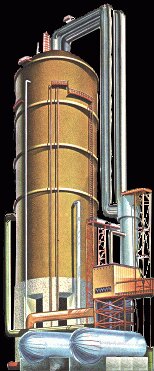Hydrocarbons From the Ground
Hydrocarbons are the main component of crude oil. Crude oil deposits are the result of decayed vegetable matter which has been subjected to heat and pressure for many millions of years. These deposits can be pumped to the surface; the crude oil contains all the different kinds of hydrocarbon molecules, which need to be separated.
|

|
Crude oil is pumped to an oil refinery, where it is separated into the various types of hydrocarbons, each of which has a distinct use. The first stage in the separation is fractional distillation, where the oil is heated. One by one, the different hydrocarbons 'boil off', with the lightest turning to vapour first, and rising to the top.

|

|
These light hydrocarbons, usually in gaseous form already, are the first to be separated out. They're used for cooking and heating. Components removed become plastics and synthetic fibres.
|

|
After impurities are removed and other hydrocarbons blended in, this fraction will become automobile fuel.
|

|
Naphtha is used as a cleaning fluid, but is also broken down further to provide additional gasoline components.
|

|
This fraction is further separated into jet fuel (kerosene), diesel, and furnace oil.
|

|
Representing about 1% of the original, this fraction is turned into heavy lubricants, asphalt, and wax.
|
|
Back
|

